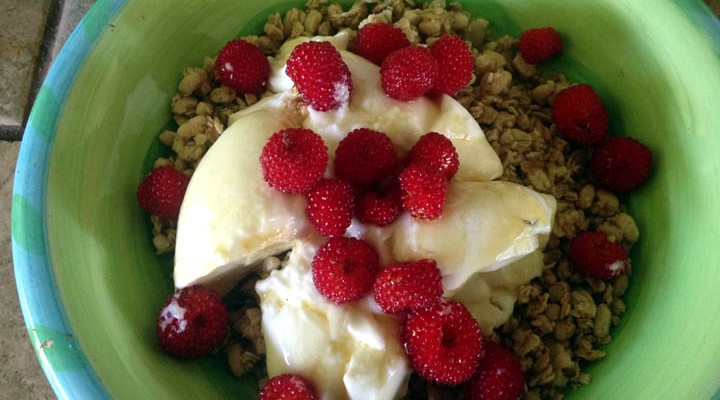 Anyone can easily make yogurt at home without a yogurt making machine or expensive kitchen gadget. What you will need is milk, an active yogurt culture (a container of Brown Cow plain yogurt will do) and a modest amount of time where you will be home (though not entirely engaged in the process).
Anyone can easily make yogurt at home without a yogurt making machine or expensive kitchen gadget. What you will need is milk, an active yogurt culture (a container of Brown Cow plain yogurt will do) and a modest amount of time where you will be home (though not entirely engaged in the process).
Basically, you need to heat the milk, add a live yogurt culture and keep it heated in a pot of hot water until it turns milk into yogurt.
To begin, check your refrigerator or your grocery store for these words on your yogurt, “Contains active live cultures.” You can use this yogurt as your starter. It’s best to use plain, but recently the only yogurt in my refrigerator was Strawberry Yoplait yogurt. I used it and it worked fine except there was a slight strawberry flavor that settled on the bottom of my homemade yogurt containers. Luckily, subsequent batches had no residual flavors.
Since I live on a farm and have dairy cows, I use skimmed, raw milk when making my yogurt which I thoroughly recommend. You can use grocery store milk, hoping that you can find organic, rBGH-free milk.
It’s very simple to make yogurt, just follow these directions: Take a ½ gallon of milk and pour it into a stainless steel pot. Heat the milk to 189 degrees, stirring more frequently as it approaches the desired temperature. At this temperature, the heat will kill any active cultures in your milk which, surprisingly, you’ll want to do in order to have a clean slate for your new yogurt culture to multiply and grow unhindered by competing cultures. After your milk reaches 189 degrees, let it cool down to 116 degrees. At this time, add two tablespoons of yogurt and whisk it into your 116 degree milk. Then pour it into four, pint-sized canning jars and cap tightly.
 Add warm water to a large pot and use a thermometer making sure the temperature does not exceed 116 degrees. Usually tap water is hot enough to use without heating it on the stove just yet. You will need a pot that will hold enough water to submerse all your jars at once. Add your jars into the 116 degree water and put the lid on the pot to hold the heat in. Take a few kitchen towels and place them on the top of the lid to insulate. I also sometimes take a beach towel and wrap up the pot to keep the heat in.
Add warm water to a large pot and use a thermometer making sure the temperature does not exceed 116 degrees. Usually tap water is hot enough to use without heating it on the stove just yet. You will need a pot that will hold enough water to submerse all your jars at once. Add your jars into the 116 degree water and put the lid on the pot to hold the heat in. Take a few kitchen towels and place them on the top of the lid to insulate. I also sometimes take a beach towel and wrap up the pot to keep the heat in.
Throughout the day, periodically check the temperature of your water and reheat bringing back the temperature to 116 degrees, leaving the jars in the pot. Do not let it go over 116 degrees when heating or you could kill your culture. Don’t be overly concerned about it dropping down too low in between checks; just put it back on the stove for a few minutes to heat it back up to 116 degrees.
Continue this process, of adjusting the temperature maybe three times or until the milk in the jars is no longer a liquid and is now, in fact, yogurt. If it is on the runny side, reheat to 116 degrees one more time. Usually this whole process takes anywhere from 4 to 6 hours.
If you have a decent cooler, you can fill it with 116 degree Fahrenheit water and place the jars in there for 4-6 hours. Just add more hot water if it starts to cool.

Yogurt and granola with berries
You have now made yogurt – a half gallon, for the price of a half gallon of milk and 2 tablespoons of yogurt. You can keep making yogurt from this same culture by saving at least 2 tablespoons and using it as a starter culture in your next batch.
If you want to make Greek yogurt, take your ready-made yogurt and put it in a fine mesh bag such as a nut-milk bag and hang it up to let the water drip out. It may take up to the day to completely release all that water and become thick. Start with a quart of yogurt and you’ll get about a pint of Greek Yogurt.
With your fresh homemade yogurt you can add it to smoothies; make salad dressings, add it to your morning granola, add honey, fruit, jam and enjoy.

do you mean degrees Celsius or degrees Fahrenheit?
Thanks a lot!
Fahrenheit. Thanks.